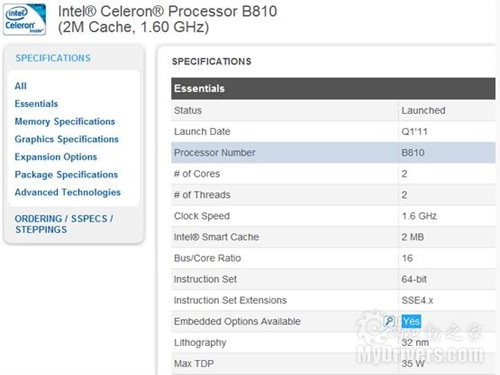 A week or so ago, we reported that Intel quietly released the first Sandy Bridge architecture to move the Celeron B110. This week Tencent Technology compiled foreign reports that the Celeron B11 has been shipped within this month.
A week or so ago, we reported that Intel quietly released the first Sandy Bridge architecture to move the Celeron B110. This week Tencent Technology compiled foreign reports that the Celeron B11 has been shipped within this month. Celeron B810 thousand wholesale price of 86 dollars for the dual-core clocked at 1.6GHz, three-level cache 2MB, support for SSE4. x instruction set, TDP power consumption 35W, memory support dual channel DDR3-1066/1333, maximum capacity 32GB, integrated graphics core HD Graphics 2000, dynamic frequency 650-950MHz, support VGA/SDVO/HDMI/DP/eDP and other video output and Dual screen display.
Compared to the standard Core i7/i5/i3, the Celeron B810 has removed a large number of technical features, including HT Hyper-Threading, Turbo Boost Turbo Boost, VT-d Virtualization (retaining VT-x), TXT Trusted Execution, and AES Directives Set, DBS on-demand switching, Quick Sync Video video hardware transcoding, Clear Video video hardware decoding, InTRU 3D stereo output, WIDI wireless output, etc. are all cut off.
Intel's first Sandy Bridge Celeron processor starts shipping According to foreign media reports, Intel's first Sandy Bridge-based Celeron notebook computer processor began shipping this month. The processor is a low-cost, simplified version of the Core i3, i5, and i7 chips.
The dual-core Celeron B810 processor has a frequency of 1.6GHz, including 2MB of cache, and a power of 35 watts. The wholesale price is 86 dollars per 1,000 tablets. Celeron processors have always been assembled with low-cost laptops. These low-cost laptops generally run basic applications such as word processing and Internet browsing. In the past two years, single-core Celeron processors have generally been used in laptops that cost less than $300 and have a 15.6-inch display. Celeron processors are generally considered to be competing products for AMD's V series and Sempron processors.
So far, PC makers have not yet introduced notebook computers using the processor.
According to product information on Intel's official website, the Celeron B810 has integrated graphics, which is the same as Core i3, i5 and i7. Recently, Dell, Hewlett-Packard and Lenovo released commercial or ultra-light laptops with the Core i3, i5, or i7. However, this Celeron B810 does not have such energy-saving and acceleration features as Turbo Boost 2.0. With this feature, idle processor cores can be turned off or enabled depending on processing power requirements.
The Celeron processor does not yet have graphics capabilities such as Quick Sync, which can convert high-definition video to smartphone-friendly formats in just a few seconds. This Celeron processor cannot transfer high-definition video streams from laptops to high-definition televisions, and laptops equipped with Core i3, i5, and i7 processors can do so.
